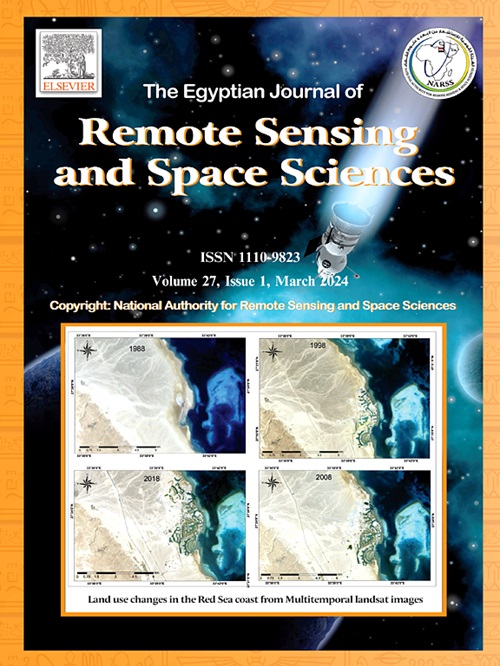填补 MODIS 和 CMEMS 提供的印度尼西亚亚齐水域叶绿素-a 卫星数据的空白
IF 3.7
3区 地球科学
Q2 ENVIRONMENTAL SCIENCES
Egyptian Journal of Remote Sensing and Space Sciences
Pub Date : 2024-09-27
DOI:10.1016/j.ejrs.2024.08.004
引用次数: 0
摘要
我们研究的动机是找出一种稳健的方法来提高缺失数据的准确性,特别是叶绿素-a 数据,因为这些数据经常由于各种因素而未被检测到。本研究使用三种方法分析了叶绿素-a 浓度和潮汐引起的海平面变化:线性插值法、填充法和修正填充法。共进行了两次实验:实验 I 涉及随机数据移除(60% 和 70%),实验 II 结合了顺序和随机数据移除(右侧顺序移除 25%,左侧随机移除 35% 和 45%)。在实验 I 中,"修正填充间隙 "方法在原始数据和重建数据之间显示出较高的相关系数(高达 0.96),证明了该方法在准确填补重要数据间隙方面的有效性。该方法还显示出较低的均方根误差和平均绝对误差,证实了其预测精度。在实验 II 中,尽管出现了结构化和现实的数据丢失模式,但该方法仍保持了高相关性和低预测误差,归一化均方根误差和平均绝对百分比误差值都很低,进一步验证了其可靠性。此外,该方法在二维叶绿素-a 地图中表现出色,在数据丢失 50% 和 60% 的情况下,其相关性更高,预测误差更小,优于线性插值法和 Fillgaps 法。这些发现对于依赖卫星数据的环境和气候学研究至关重要,证实了修正的 Fillgaps 方法是处理叶绿素-a 地图分析中大量数据丢失的最可靠、最有效的方法。未来的研究应探索该方法在其他环境数据类型和更复杂的数据丢失模式中的应用。本文章由计算机程序翻译,如有差异,请以英文原文为准。
Gap filling of missing satellite data from MODIS and CMEMS for chlorophyll-a in the waters of Aceh, Indonesia
The motivation behind our study is to identify a robust method to enhance the accuracy of missing data, particularly chlorophyll-a data, which often goes undetected due to various factors. This study analyzes chlorophyll-a concentrations and sea level changes due to tides using three methods: Linear Interpolation, Fillgaps, and Modified Fillgaps. Two experiments were conducted: Experiment I involved random data removal (60% and 70%), and Experiment II combined sequential and random data removal (25% sequentially on the right, 35% and 45% randomly on the left). In Experiment I, the Modified Fillgaps method showed high correlation coefficients (up to 0.96) between original and reconstructed data, demonstrating its effectiveness in accurately filling significant data gaps. This method also exhibited low Root Mean Square Error and Mean Absolute Error values, confirming its predictive precision. In Experiment II, despite structured and realistic data loss patterns, the method maintained high correlation and low prediction errors, with low Normalized Root Mean Squared Error and Mean Absolute Percentage Error values, further validating its reliability. Additionally, the method excelled in two-dimensional chlorophyll-a maps, outperforming Linear Interpolation and Fillgaps methods in scenarios with 50% and 60% data loss, achieving higher correlation and lower prediction errors. These findings are crucial for environmental and climatological studies relying on satellite-derived data, confirming the Modified Fillgaps method as the most reliable and effective for handling significant data loss in chlorophyll-a map analyses. Future research should explore its application to other environmental data types and more complex data loss patterns.
求助全文
通过发布文献求助,成功后即可免费获取论文全文。
去求助
来源期刊
CiteScore
8.10
自引率
0.00%
发文量
85
审稿时长
48 weeks
期刊介绍:
The Egyptian Journal of Remote Sensing and Space Sciences (EJRS) encompasses a comprehensive range of topics within Remote Sensing, Geographic Information Systems (GIS), planetary geology, and space technology development, including theories, applications, and modeling. EJRS aims to disseminate high-quality, peer-reviewed research focusing on the advancement of remote sensing and GIS technologies and their practical applications for effective planning, sustainable development, and environmental resource conservation. The journal particularly welcomes innovative papers with broad scientific appeal.

 求助内容:
求助内容: 应助结果提醒方式:
应助结果提醒方式:


